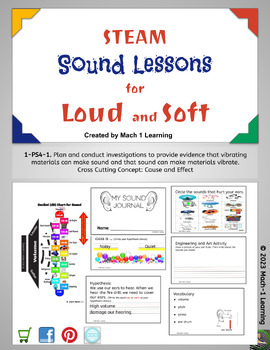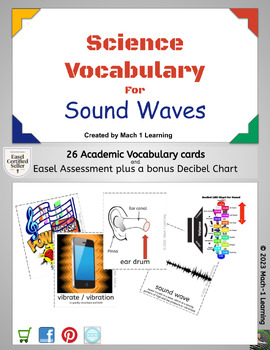NGSS Sound Energy Unit (Bundle)
Mach 1 Learning
17 Followers
Grade Levels
1st - 4th, Homeschool
Subjects
Resource Type
Standards
NGSS1-PS4-4
NGSS4-PS4-1
NGSS1-PS4-1
NGSS4-PS4-3
Formats Included
- Zip
- Easel Activity
- Easel Assessment
Pages
60 pages
Mach 1 Learning
17 Followers
Easel Activities Included
Some resources in this bundle include ready-to-use interactive activities that students can complete on any device. Easel by TPT is free to use! Learn more.
Easel Assessment Included
Some resources in this bundle include self-grading quizzes that students can complete on any device. Easel by TPT is free to use! Learn more.
Products in this Bundle (3)
Description
This bundle includes several lessons for exploring Sound Energy. The STEAM activities integrates the scientific process, journal writing, art, music, and PE activities. It is geared toward the 1st and 4th grade NGSS standards. The lessons are great for a substitute.
Sound is a type of energy made up of vibrations, or sound waves, that we use our sense of hearing to understand. The sound waves are made from an object vibrating, or moving back and forth very quickly. These sound waves travel through air, water, and other matter.
We use our ears to hear sound. Our ears have a delicate skin on the inside that vibrates like a drum. Our brain recognizes this vibration as sound.
What is included in this Bundle:
- Introduction to Sound Wave (STEAM) - students will explore that vibrations are responsible for the sounds we make and hear
- NGSS Sound Waves - Exploring Volume (STEAM) - students will explore decibels
- Science Vocabulary for Sound - Understanding the academic vocabulary for Sound Energy can be challenging. This product provides pictures with the scientific academic terms. It also includes an Easel Assessment that can be given before starting the lesson to determine the level of prior knowledge of your students and as a summative assessment.
Total Pages
60 pages
Answer Key
Does not apply
Teaching Duration
N/A
Report this resource to TPT
Reported resources will be reviewed by our team. Report this resource to let us know if this resource violates TPT’s content guidelines.
Standards
to see state-specific standards (only available in the US).
NGSS1-PS4-4
Use tools and materials to design and build a device that uses light or sound to solve the problem of communicating over a distance. Examples of devices could include a light source to send signals, paper cup and string "telephones," and a pattern of drum beats. Assessment does not include technological details for how communication devices work.
NGSS4-PS4-1
Develop a model of waves to describe patterns in terms of amplitude and wavelength and that waves can cause objects to move. Examples of models could include diagrams, analogies, and physical models using wire to illustrate wavelength and amplitude of waves. Assessment does not include interference effects, electromagnetic waves, non-periodic waves, or quantitative models of amplitude and wavelength.
NGSS1-PS4-1
Plan and conduct investigations to provide evidence that vibrating materials can make sound and that sound can make materials vibrate. Examples of vibrating materials that make sound could include tuning forks and plucking a stretched string. Examples of how sound can make matter vibrate could include holding a piece of paper near a speaker making sound and holding an object near a vibrating tuning fork.
NGSS4-PS4-3
Generate and compare multiple solutions that use patterns to transfer information. Examples of solutions could include drums sending coded information through sound waves, using a grid of 1’s and 0’s representing black and white to send information about a picture, and using Morse code to send text.





